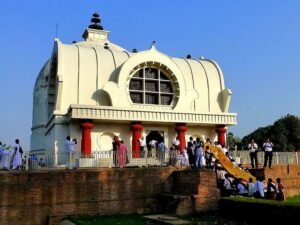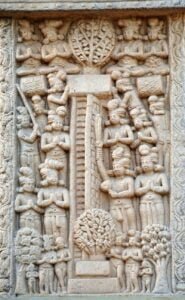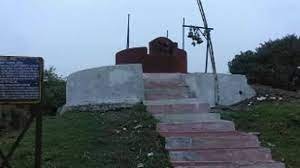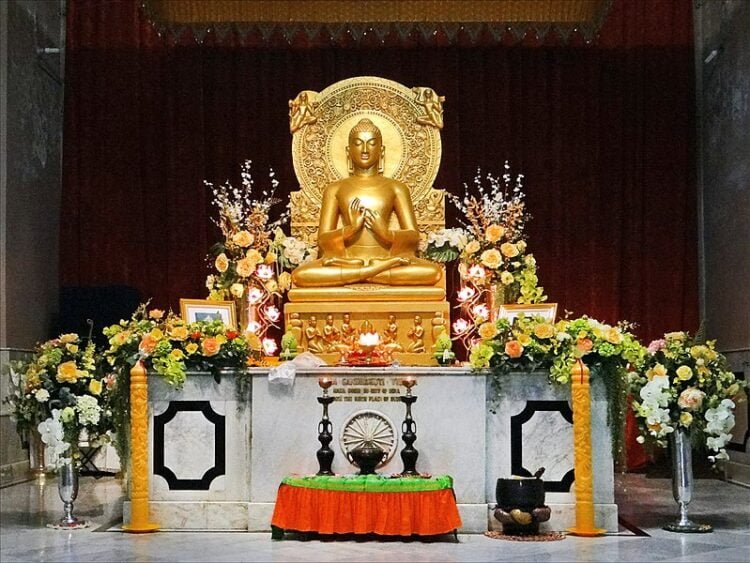No products in the cart.
The Buddhist Circuit in the Heart of Uttar Pradesh
Embark on a Spiritual Odyssey
Welcome to the Path of the Buddha, meticulously organized and simplified as ‘The Buddhist Circuit.’ Uttar Pradesh Tourism takes pride in being an integral part of this international pilgrimage route. Unquestionably, Uttar Pradesh stands as the cradle of Buddhism, where the multifaceted facets of Lord Buddha’s life unfold for the fortunate to witness and absorb. The essence of the Lord still permeates the air in Uttar Pradesh, and the profound experience of Lord Buddha’s life in this sacred land is unparalleled. A visit is not just recommended; it is an invitation to immerse oneself in the spiritual aura.
This journey is a quest for internal peace, a sojourn through austere Stupas and ancient monasteries resonating with the mystical chants of sacred Buddhist mantras. The experience instantly transports you to a bygone era, thousands of years in the past, when a prince relinquished worldly pleasures to embrace asceticism, centuries before the birth of Christ.
The narrative is ancient, and every point on the Buddhist circuit is steeped in myth and meaning. Each monument stands as a testament to faith intertwined with reality, as centuries passed and oral heritage transformed. In Sanskrit, ‘Bodh’ signifies knowledge; thus, Buddha translates to ‘One who has attained all knowledge’ or ‘One in whom there is no conflict, no suffering’ – in essence, one who has mastered oneself. The Chinese refer to him as the Zen Master.
Gautama Buddha traversed the Gangetic Plains, sharing his doctrine with the people for over 40 years. This pilgrimage marks the dissemination of Buddhism across the world, elevating Gautama Buddha to the status of a revered saint.
If you seek to rediscover the Buddha within you, come and explore this sacred
Kapilvastu – Tracing the Footsteps of Lord Buddha

Once the thriving capital of the mighty Shakya clan, Kapilvastu cradled the early childhood of Prince Siddharth, later known as Lord Buddha. Within the opulent confines of Kapilvastu, King Suddhodhana, the father of the Enlightened One, held sway as the reigning monarch.
Today, the archaeological findings at the site align with the modern township of Piprahwa, located just one and a half kilometers away. Notably, two excavated mounds grace this historical landscape.
The larger of the two mounds, distinguished by its robust, thick-walled structure, is believed to be the remnants of King Suddhodhana’s palace. A testament to the grandeur that once adorned this capital city.
The second mound unveils the ruins of the Piprahwa Stupa, a solemn structure erected by the Shakya rulers. During excavations, a significant discovery was made – an inscribed seal bearing the words ‘Om Devaputra Vihare Kapilvastu Bhikku Sanghas’ (This is the Devaputra Vihara of the Kapilvastu Bhikshu Sangha). This inscription provides a glimpse into the religious and historical significance of the site.
Furthermore, nestled in the proximity of these ancient ruins lies a small Sri Lankan monastery known as the Mahindra Mahavihara, adding an international dimension to the cultural tapestry of Kapilvastu. As visitors tread upon this sacred ground, they are transported back in time to the epoch when the young Siddharth walked these very paths, and King Suddhodhana’s palace stood as a testament to the regal heritage of Kapilvastu.
Place where prince Siddharth grew up as a child
Meandering their way through Kapilvastu, the devotees feel transferred thousands of years back to an era when young Prince Siddharth having seen the pains of life. renounced all worldly riches and pleasures in search of the path which leads to cessation of suffering and salvation for which he proceeded to Bodhgaya, now in Bihar.
Accessibility
Air: Gorakhpur Airport-109 km. , Sravasti airstrip-146 km., Kasia airstrip-160 km.
Chaudhary Charan Singh International Airport, Lucknow -310 km.
Lal Bahadur Shastri International Airport, Varanasi-330 km.
Rail: Nearest Railway Station is Naugarh 22 km.
Road : Some of the major road distances are: Berdpur-8 km., Sonauli-48 km., Lumbini (Nepal)-86 km., Gorakhpur-104 km., Sravasti-147 km., Kushinagar-157 km., Lucknow-308 km., Varanasi-327 km.
Accommodation
Sri Lankan Temple Dharamshala
The Royal Retreat (Heritage Hotel) Mohana-Shohratgarh
route (14 km from Kapilvastu).
Satkar Hotel at Navgarh (22 km)
Sarnath

Where Buddha held his first public discourse
Sarnath is the place where more than 2,500 years ago Buddha delivered his first sermon after attaining enlightenment. An imposing conical structure, 34 meters in height, called Dhamek Stupa signifies the “seat of the holy Buddha.” There are also the ruins of Dharmarajika Stupa, besides the original Mulgandha Kuti Vihara, which according to Hieun Tsang was about 61 meters high. That is the place where Buddha rested and meditated in Sarnath. After converting to Buddhism, Emperor Ashoka visited Sarnath in 273-232 B.C. and erected a smooth glistening stone pillar here, to mark the foundation of the Buddhist Sangha. The Lion Capital on top of this pillar is now India’s National Emblem. Then there is Chaukhandi Stupa, which was a terraced temple during the Gupta period (4th to 6th century). All three stupas- Dharmarajika, Chaukhandi and Dhamek are outstanding in their architectural features.
A journey to Sarnath would be incomplete without a visit to the library at Mulgandh Kuti Vihara, which houses some amazing frescoes done by Koset Nosu. The Sarnath Museum houses some of the finest specimens of Buddhist sculpture. Many temples & monasteries of different countries are located in Sarnath. The Garden of Spiritual Wisdom at Sarnath uses a mix of exhibits and sculptures to convey the essentials of Buddhism igniting an interest to further explore the subject of spirituality. Ayurvedic plants in the garden, collected from different parts of the country offer a glimpse of Ayurveda.
Accessibility
Air: Lal Bahadur Shastri International Airport, Varanasi: 30 Km.
Rail: Sarnath is directly connected by trains like- Gorakhpur Exp 55149/55150 and Budha Purnima Express 14223/14224 from Bodhgaya,
Road Sarnath, 10-km from Varanasi, is well connected by road to other destinations of the state as well as country.
UP Tourism Accommodation
Rahi Tourist Bungalow, Mrigdave, (A unit of UPSTDC), Sarnath.
e-mail.: rahimrigdave@up-tourism.com
Other Accommodation in Sarnath
Forest Rest House, Sarnath
Mahabodhi Society Dharamshala, Sarnath
Jain Dharamshala, Sarnath
Hotel Buddha International, Sarnath
Sarnath Motel & Resort.
Hotel Surabhi International
Hotel Lotus Inn, Mawaiya, Sarnath
Shivam Guest House, Sarnath
Hotel Chaitanya Inn, Anmol Nagar Colony, Sarnath
New Sarnath Guest House, Sarnath
Kaushambi

In his bid to spread his message Lord Buddha also visited Kaushambi, 60km. from Prayagraj, counted amongst the most prosperous cities of those times.
During that period, it was the capital city of the then Vatsa Janpada, with Udyan, a scion of the Bharatas family (Bharat-kula), as the king
This place is believed to have been visited by Lord Buddha in the 6th and 9th year after attaining enlightenment on his effort to spread the dharma, the Noble Eightfold Path and the Four Noble Truths,
He delivered several sermons here, elevating it to a centre of higher learning for the Buddhists.
Excavations have revealed ruins of an Ashokan Pillar, an old fort and the Ghositarama Monastery, besides a huge number of sculptures and figurines, cast coins and terracotta objects.
Where Buddha delivered many a sermons
Shravasti

The town played host to Lord Buddha for 27 years and was his annual rainy season retreat, Believed to be founded by the mythological King Sravast the site holds ruins of many ancient Stupas, majestic monasteries and beautiful temples. This place also has an Anand Bodhi tree, an offspring of the original bodhi tree, planted by Buddha’s main disciple Anand.
The site of Maheth is spread over an area of 400 acres. The two main attractions here are the Pakki Kuti and the Kachchi Kuti. While Sahet, spread over an area of 32 acres and a little distance away from Maheth, is where Anathpindak, a wealthy merchant, constructed the Jetavana Vihar. The remnants of several temples, Stupas and Viharas have been found here. The huge World Peace Bell is another attraction, which conveys Lord Buddha’s message of humanity through the bell’s toll. The Thai – Sri Lankan – Myanmar-Chinese- Korean Buddhist Temples, the Shobhnath Temple, Swarna Gandha Kuti, the Ananda Bodhi Tree and the Angulimal Cave are also here.
His favorite monsoon retreat
Daen Mahamongkolchai
Set up as a centre of learning by Maha Upasika Sitthipol Bongkot of Thailand, this meditation centre is a unique experience. The entire area is converted into a natural forest surrounded by a fresh water reservoir. Its meditation hall areas, ecofriendly dwelling, management and lifestyle inculcate a sense of protection of biodiversity and compassion for all beings.
Accessibility
Air: Chaudhary Charan Singh International Airport, Lucknow -176 km.
Rail: Nearest railway station is at Balrampur: 17 km. The rest of the route can be covered by road.
Road: Bus services are available from all major neighboring centres. Shravasti is -119 km from Basti and – 17 km. from Balrampur.
UP Tourism Accommodation
Tourist Bungalow, Shravasti, Distt. Shravasti (Run by U.P. State Tourism Development Corporation)
Other Accommodation
1. Inspection Bungalow, PWD.
2. Burmese Temple Rest House.
3. Temple Rest House.
4.Jain Dharamshala.
Kushinagar
 Kushinagar, is one of the principal centre of Buddhist pilgrimage, is the place where Lord Buddha left his corporal self and attained Mahaparinirvana. The credit for bringing this ancient site to light goes to General A. Cunningham and A.C.I. Carlyl, after excavating the site in 1861. Later, between 1904 and 1912, several excavations conducted by the Archaeological Survey of India at Kushinagar confirmed its identity.
Kushinagar, is one of the principal centre of Buddhist pilgrimage, is the place where Lord Buddha left his corporal self and attained Mahaparinirvana. The credit for bringing this ancient site to light goes to General A. Cunningham and A.C.I. Carlyl, after excavating the site in 1861. Later, between 1904 and 1912, several excavations conducted by the Archaeological Survey of India at Kushinagar confirmed its identity.
The monuments of Kushinagar are situated in three distinct groups comprising the main site of the Nirvana Temple, the central stupa and surrounding monasteries, the Matha Kuar shrine to the southwest, and the Ramabhar Stupa a kilometer to the east.
Where he attained Maha Parinirvana (Demise)
Nirvana Stupa is a huge brickwork stupa which stands at a height of 2.74 mtr. A copper vessel was unearthed at this site. It bore an inscription in ancient Brahmi, which stated that Lord Buddha’s remains had been deposited here. Matha Kuar shrine lies about 400 yards from the Parinirvana Stupa. A black stone image of the Buddha in the bhumisparsha mudra was recovered here. The last sermon by Lord Buddha was given here. Ramabhar Stupa is a large stupa which rises to a height of 49 ft. It marks the site where the Lord Buddha was cremated. In ancient Buddhist texts this stupa has been referred to as Mukut-Bandhan Vihar.
Accessibility
Air: Kushinagar International Airport, Kushinagar – 5km., Kasia airstrip-5 km, Gorakhpur Airport-46 km, Lal Bahadur Shastri International Airport, Varanasi-286 km. Chaudhary Charan Singh International Airport, Lucknow- 355 km.
Rail: The nearest railway stations are Deoria 35 km and Gorakhpur 53 km, which are linked with important destinations. Kushinagar does not have a railway station, one has to go up to Gorakhpur by train and from there reach Kushinagar by road.
Road: Situated on National Highway No. 28, with frequent bus services, Kushinagar is well connected with other parts of the state. Some major road distances are: Gorakhpur-53 km. Kapilvastu-157 km, Lumbini (Nepal)-170 km, Sravasti-253 km, Sarnath-274 km.
UP Tourism Accommodation
Rahi Pathik Niwas (UPSTDC), Kushinagar.
e-mail.: rahipathikniwas@up-toursim.com
Other Accommodation
1. Hotel Nekko Lotus, (3 Star) International Guest House.
2. Birla Hindu Buddha Dharamshala.
3. Burmese Dharamshala
4. Hotel Royal Residency, (3 Star)
5. Hotel The Imperial, (3 Star)
6. Linshon Chinese Rest House
Sankisa

Sankisa is identified with the present village of Basantpur in Farrukhabad district of Uttar Pradesh. Sankisa is related to many myths pertaining to Lord Buddha, especially his descending from the heaven along with Lord Brahma and Devraj Indra after giving a discourse to his mother, Mayadevi Emperor Ashoka erected an elephant pillar here to mark this holy spot. This elephant is said to be the representation of the white elephant which Mayadevi had dreamt at the time of conception of Siddhartha (Lord Buddha). Known as Sankasya in Ramayana, this village has been an important centre in the geography of India from earlier times. Hieun Tsang named this city as Kapittha in his travelogue and described it as a nice place to visit.
There is a small temple of Bisari Devi where, she is worshipped as a goddess of fertility. Buddhist sculptures dating back to Mahayana age is also found on some walls at the site.
Where he descended after addressing his mother in Heaven
The excavations by ASI has lead to the findings of many items of ancient age contemporary to Buddha and Ashoka These items are exquisite and represents high grade of art. The scriptures, terracotta figures, bronze coins and stone dishes remain the centre of attraction.
The Shiva linga is also quite exotic and attracts Hindu religious devotees.
Accessibility
Air: Agra Airport 207 km.. Chaudhary Charan Singh International Airport, Lucknow 245 km.
Rail: Nearest railway station Pakhana (10 km.) and Neemkaroli (14 km.)
Road: Fatehgarh 40km., Farrukhabad 45 km., Kanpur 175km., Agra 200km.
UP Tourism Accommodation Rahi Tourist Bungalow, Sankisa. (A Unit of UPSTDC)
Other Accommodation
1.Hotel The Royal Residency.
2. Maitreya (Sri Lanka) Buddha Vihar.
3.Myanmar Buddha Vihar.
Devdah (Maharaj Ganj)

Maharaj Ganj is one of the districts in Uttar Pradesh in northern India. This is located in Terrain regions of Himalayas, bordering Nepal in North. This district covers an area of 2951 sq. km. The Religious temples Lehra Devi and Itahiya Panchmukhi Shiv Mandir is famous in the region and in Nepal.
The mother of Lord Gautam Buddha Mahamaya, aunt Mahaprajapati Gautami and wife Bhadra Katyayani (Yashodhara) have been told to relate only to Devdah Nagar. The remains of a town, fort and stupa have been available on 88.8 acres of land in Bansih-Kala, situated near the Haunted Market of Maharajganj district.
Ramgram is the ancient place where a stupa containing the relics of Lord Buddha is supposed to build by Koliya after Mahaparinirvana of Buddha.
Where the mother, mousi and wife of Lord Buddha have been told to relate only to
Accessibility
Air :Direct flights from New Delhi Indira Gandhi International Airport to Gorakhpur Airport 55 km. approx. by road from Gorakhpur Airport
Rail:8 hrs 10 minutes from Delhi to Lucknow The distance between Lucknow and Maharajganj is 259 km.
Road: Well connected from Lucknow through via NH 27
Accommodation
Hotel Nirvana Luxury International Hotel The White Lotus View
















